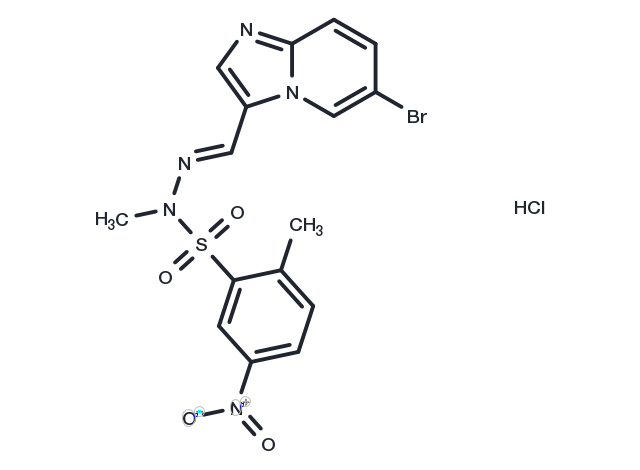Powder: -20°C for 3 years | In solvent: -80°C for 1 year


PIK-75 hydrochloride (PIK-75 HCl) is a p110α inhibitor with IC50 of 5.8 nM (200-fold more potently than p110β), isoform-specific mutants at Ser773, and also potently inhibits DNA-PK with IC50 of 2 nM in cell-free assays.

| Pack Size | Availability | Price/USD | Quantity |
|---|---|---|---|
| 5 mg | In stock | $ 36.00 | |
| 10 mg | In stock | $ 48.00 | |
| 25 mg | In stock | $ 76.00 | |
| 50 mg | In stock | $ 126.00 | |
| 100 mg | In stock | $ 178.00 | |
| 1 mL * 10 mM (in DMSO) | In stock | $ 64.00 |



| Description | PIK-75 hydrochloride (PIK-75 HCl) is a p110α inhibitor with IC50 of 5.8 nM (200-fold more potently than p110β), isoform-specific mutants at Ser773, and also potently inhibits DNA-PK with IC50 of 2 nM in cell-free assays. |
| Targets&IC50 | DNA-PK:2 nM |
| Kinase Assay | Inhibition Assays: The PI3K inhibitor PIK-75 is dissolved at 10 mM in dimethyl sulfoxide and stored at ?20°C until use. PI3K enzyme activity is determined in 50 μL of 20 mM HEPES, pH 7.5, and 5 mM MgCl2 containing 180 μM phosphatidyl inositol, with the reaction started by the addition of 100 μM ATP (containing 2.5 μCi of [γ-32P]ATP). After a 30-minute incubation at room temperature, the enzyme reaction is stopped by the addition of 50 μL of 1 M HCl. Phospholipids are then extracted with 100 μL of chloroform/methanol [1:1 (v/v)] and 250 μL of 2 M KCl followed by liquid scintillation counting. Inhibitors are diluted in 20% (v/v) dimethyl sulfoxide to generate a concentration versus inhibition of enzyme activity curve, which is then analyzed with the use of Prism version 5.00 for Windows to calculate the IC50. For kinetic analysis, a luminescent assay measuring ATP consumption is used. PI3K enzyme activity is determined in 50 μL of 20 mM HEPES, pH 7.5, and 5 mM MgCl2 with PI and ATP at various concentrations. After a 60-minute incubation at room temperature, the reaction is stopped by the addition of 50 μL of Kinase-Glo followed by a further 15-minute incubation. Luminescence is then read using a Fluostar plate reader. Results are analyzed using Prism. |
| Cell Research | Mitochondrial activity is assessed after stimulation with TGFβ with or without inhibitors for 48 hours using the 3-(4,5-dimethylthiazol-2-yl)-2,5-diphenyltetrazolium (MTT) assay. Harvested washed cells are resuspended in DMEM-lO% FCS and aliquoted (500 μL) into 24-well cluster plates prior to serial dilution (1:2) in duplicates. To each well, 100 μL of an appropriate MTT concentration (dissolved in PBS and filtered through a 0.2 μm filter before use to remove any blue formazan product) is added immediately after diluting the cells, which are then incubated for 3.5 hours at 37 °C. The resulting blue formazan product is solubilized overnight (16 hours) at 37 °C by the addition of 500 μL of 10% sodium dodecyl sulfate (SDS) in 0.01 M HCl to each well. A sample (150 μL) from each duplicate well is transferred to a 96-well microplate, and the optical density determinedby automated spectrophotometry against a reagent blank (no cells). Absorbance is measured at a test wavelength of 570 nm and a reference wavelength of 690 nm. For each primary cell culture, results from three to six wells from each treatment are averaged, and data are expressed as absorbance 570 to 690 nm.(Only for Reference) |
| Synonyms | PIK-75 HCl, PIK-75 |
| Molecular Weight | 488.74 |
| Formula | C16H14BrN5O4S·HCl |
| CAS No. | 372196-77-5 |
Powder: -20°C for 3 years | In solvent: -80°C for 1 year
DMSO: Slightly soluble
You can also refer to dose conversion for different animals. More
bottom
Please see Inhibitor Handling Instructions for more frequently ask questions. Topics include: how to prepare stock solutions, how to store products, and cautions on cell-based assays & animal experiments, etc.
PIK-75 hydrochloride 372196-77-5 Apoptosis DNA Damage/DNA Repair PI3K/Akt/mTOR signaling PI3K DNA-PK Inhibitor apoptotic PIK 75 hydrochloride Phosphoinositide 3-kinase CHO-IR inhibit PIK-75 HCl pancreatic cancer cells PIK75 Hydrochloride DNA-dependent protein kinase PIK 75 PIK-75 Hydrochloride p110α PKB PIK75 PIK-75 PIK 75 Hydrochloride PIK75 hydrochloride inhibitor
